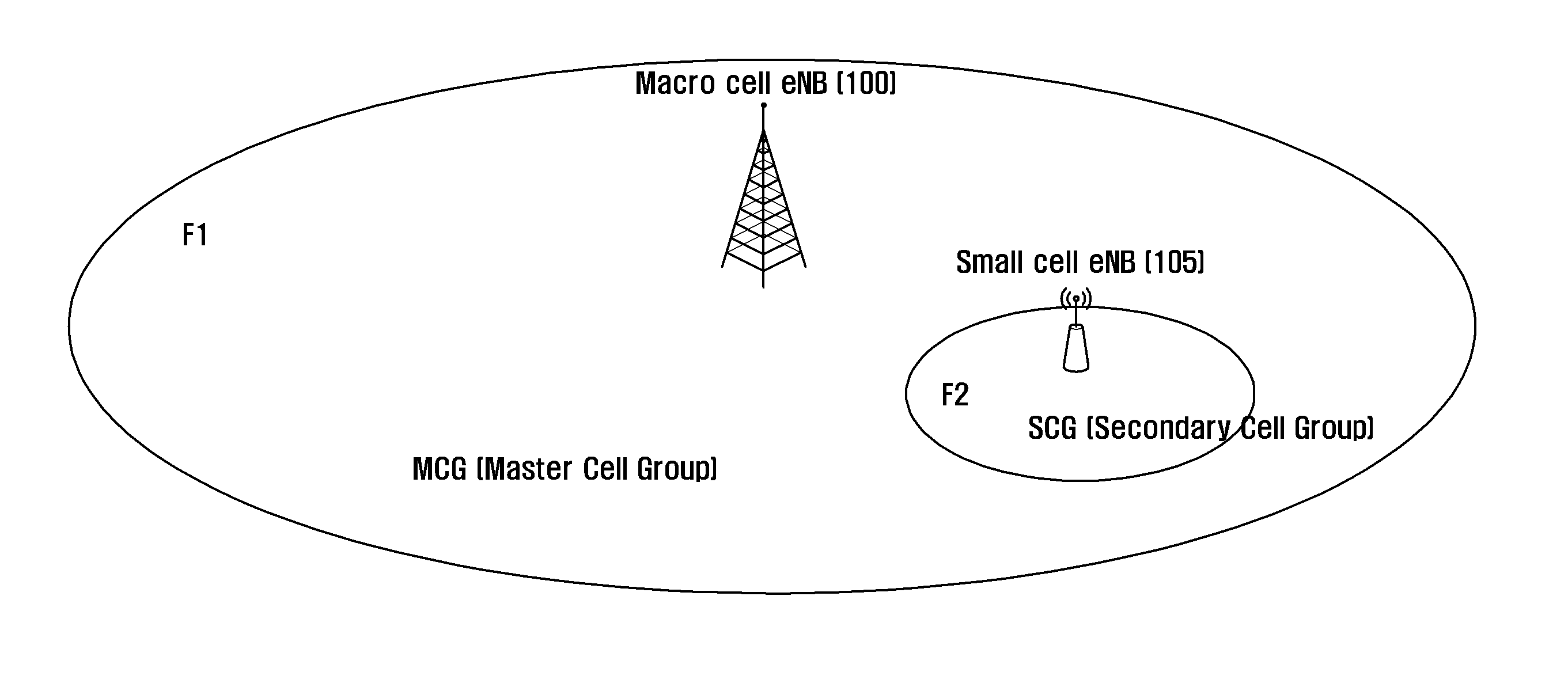Method for acquiring system frame number by terminal, terminal, and mobile communication system
a mobile communication system and system frame number technology, applied in the field of small cell operation, can solve the problems of scarce research on system parameter application or operation mechanism suitable for small size service area
- Summary
- Abstract
- Description
- Claims
- Application Information
AI Technical Summary
Benefits of technology
Problems solved by technology
Method used
Image
Examples
embodiment 1
[0035]This embodiment proposes two methods of providing the SFN information to the SCG when different SFNs are applied to the MCG and SCG. In the legacy LTE Rel-10 Carrier Aggregation (CA), the same SFN(System Frame Number) is applied to the Primary Cell (PCell) and Secondary Cell (SCell). The CA technique is characterized in that a service is provided through a plurality of serving cells unlike the conventional technique in which a service is provided through one serving cell. Here, the cell playing the same role as the legacy serving cell is the PCell. The eNB can receive feedback information from the UE through a Physical Uplink Control Channel (PUCCH) and perform the operations related to handover and Radio Link Monitoring / Radio Link Failure (RLM / RLF) in the PCell. Also, the UE acquires essential information from the System Information (SI) broadcast by the eNB. Examples of the information may include SFN, frequency bandwidth, cell ID, access barring information, and idle mode c...
embodiment 2
[0043]This embodiment is directed to an RRC diversity technique. The RRC diversity is a technique of improving the successful reception probability of an RRC message by transmitting / receiving the same RRC message repeatedly from / to the multiple eNBs to / from the UE. The RRC diversity can be applied in downlink (DL) and uplink (UL). In the DL RRC diversity, the UE receives the same RRC message from a plurality of eNBs. In the UL RRC diversity, the UE transmits the same RRC message to a plurality of eNBs. This may increase successful transmission probability of the RRC message at the cell edge.
[0044]FIG. 4 is a diagram illustrating the concept of the RRC diversity technique.
[0045]Referring to FIG. 4, the UE 400 receives the same RRC message from the two eNBs, i.e. the Master eNB (MeNB) 405 and the Secondary eNB (SeNB) 410, simultaneously. The RRC message addressed to the UE is exchanged through the Xn backhaul between the MeNB and SeNB. The two eNBs may operate on the same frequency or...
embodiment 3
[0055]If a predetermined cause occurs, the Universal Mobile Telecommunication System (UMTS) and LTE systems reject the connection request of the UE and perform redirection to facilitate connection to the counterpart system. If the connection request is rejected, the UE attempts connection to the counterpart system based on the redirection information. Depending on the case, however, the UE may fail to establish a connection to any system and just repeat redirection. The present invention proposes a method to resolve this non-preferred situation.
[0056]Prior to the explanation of the present invention, the problems to be solved are described. FIG. 8 is a diagram for explaining a situation in which a UE fails to establish a connection to any system but just continues performing redirection.
[0057]Referring to FIG. 8, a UE 805 attempts connection establishment with a UMTS base station 800. For this purpose, the UE 805 sends the base station 800 an RRC CONNECTION REQUEST message at step 8...
PUM
 Login to View More
Login to View More Abstract
Description
Claims
Application Information
 Login to View More
Login to View More - R&D
- Intellectual Property
- Life Sciences
- Materials
- Tech Scout
- Unparalleled Data Quality
- Higher Quality Content
- 60% Fewer Hallucinations
Browse by: Latest US Patents, China's latest patents, Technical Efficacy Thesaurus, Application Domain, Technology Topic, Popular Technical Reports.
© 2025 PatSnap. All rights reserved.Legal|Privacy policy|Modern Slavery Act Transparency Statement|Sitemap|About US| Contact US: help@patsnap.com



